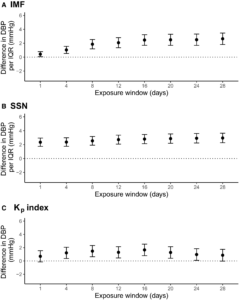Researchers Identified an Effect in Older Veterans
BOSTON — Hypertension is a known risk factor for cardiovascular disease, the leading cause of death in the United States. While blood pressure is affected by several lifestyle factors, including tobacco use, physical activity and diet, it also can be influenced by the autonomic nervous system, which plays an important role in regulating blood pressure.
The autonomic nervous system, in turn, is influenced by changes in the environment, such as geomagnetic disturbances, which are temporary changes to the Earth’s natural magnetic field caused by solar winds. Although scientists aren’t exactly sure of the mechanism behind this phenomenon, it may be that changes in the magnetic and the electromagnetic environment can alter the body’s circadian rhythm by affecting the secretion melatonin, a hormone that helps control the sleep-wake cycle.
Recently, a team of researchers set out to investigate the association between solar activity and geomagnetic disturbances and blood pressure among older adults, a population that is particularly susceptible to cardiovascular disease.1
“Our decision to [study this] was motivated by the research group’s previous work examining geomagnetic disturbances and the risk of cardiovascular death,” said the study’s lead author, Veronica A. Wang, MS, of the Department of Environmental Health at Harvard T.H. Chan School of Public Health. (In a large epidemiological study published in 2019, scientists had found that geomagnetic disturbances driven by solar activity increased both the total and cardiovascular mortality risk among residents of 263 U.S. cities.) “This led to our hypothesis that solar and geomagnetic disturbances may impact blood pressure.”2
The researchers, who worked with the VA Boston Healthcare System, examined blood pressure data from 675 elderly men enrolled in the Normative Aging Study, a longitudinal study on health and aging established by the VA in 1963. They also analyzed historic data on sunspots, interplanetary magnetic field intensity and global geomagnetic activity from the NASA Goddard Space Flight Center.
The researchers noted that there is limited understanding of the most relevant exposure window of geomagnetic activity on blood pressure, so they performed a repeated measures analysis to explore how average blood pressure measurements were affected during 28-day exposure windows, tracking changes in four-day increments. The study adjusted for several independent variables associated with changes in blood pressure, including body mass index and smoking status, as well as environmental factors known to impact blood pressure, including ambient air pollutants and particle radioactivity.
“We wanted to demonstrate that, even after accounting for these common pollutants, we still see a connection between solar activity/geomagnetic disturbances and elevated blood pressure,” Wang told U.S. Medicine.
Higher Blood Pressure
The researchers observed that increases in solar and geomagnetic activity were associated with higher diastolic and systolic blood pressure and that the effects were cumulative, reaching a pinnacle weeks after exposure. Although the researchers stressed that it’s challenging to draw conclusions from a single study, their findings may be important to consider in comparing results of blood pressure studies conducted at different locations and times. The study also noted that solar activity, which has a significant impact on ultrafine particle concentrations, may influence the known effects of particulate air pollution on blood pressure.
“Solar activity isn’t something that we often think about as being related to human health, as it’s literally activity that originates outside of our planet,” said Wang. “Our paper is really geared toward bringing awareness to solar activity as an exposure so that we, as scientists, can begin to think and investigate its effects on a deeper level.”
To better understand the specifics of how solar activity can impact human health, the researchers said that further exploration is needed of the underlying mechanisms and pathways. They also would like to see their findings assessed and reproduced in other populations, as this study’s population consists of primarily white, elderly men and might not be generalizable to other groups.
“Overall, we really do not know much about the specifics of how solar activity can impact health, and much of the underlying mechanisms and pathways are still under investigation,” Wang explained. “We are just starting to understand this novel exposure, and it’s really exciting to see how this field will develop in the coming years.”
- Wang VA, Zilli Viera CL, Garshick E, Schwartz JD, et. al. Solar Activity Is Associated With Diastolic and Systolic Blood Pressure in Elderly Adults. Journal of the American Heart Association. Published Nov. 2, 2021. DOI: 10.1161/JAHA.120.021006
- Zilli Vieira CL, Alvares D, Blomberg A, Schwartz J, et. al. . Geomagnetic disturbances driven by solar activity enhance total and cardiovascular mortality risk in 263 U.S. cities. Environmental Health. Published Sept. 11, 2019. DOI: 10.1186/s12940-019-0516-0

